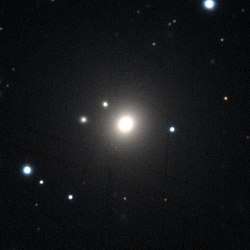NGC 1272
NGC 1272 is a massive[2] elliptical galaxy[3] located about 230 million light-years away[4] in the constellation Perseus.[5] It was discovered by astronomer Heinrich d'Arrest on February 14, 1863.[6] NGC 1272 has an active nucleus and is the second brightest[2] member of the Perseus Cluster[7][6] after NGC 1275.[2]
| NGC 1272 | |
|---|---|
 PanSTARRS image of NGC 1272 | |
| Observation data (J2000 epoch) | |
| Constellation | Perseus |
| Right ascension | 03h 19m 21.3s[1] |
| Declination | 41° 29′ 26″[1] |
| Redshift | 0.012725[1] |
| Helio radial velocity | 3815 km/s[1] |
| Distance | 226 Mly (69.2 Mpc)[1] |
| Group or cluster | Perseus Cluster |
| Apparent magnitude (V) | 12.86[1] |
| Characteristics | |
| Type | cD, E+[1] |
| Size | ~200,000 ly (60 kpc) (estimated)[1] |
| Apparent size (V) | 2.0 x 1.9[1] |
| Half-light radius (physical) | ~36,000 ly (11 kpc) (estimated)[2] |
| Other designations | |
| CGCG 540-98, MCG 7-7-58, PGC 12384, UGC 2662[1] | |
Radio jets
NGC 1272 has two radio jets which are powered by an AGN at the center of the galaxy. The jets are bent and have a radius of curvature of ~6,500 ly (2 kpc). The morphology of the jets indicate that the jets are affected by ram-pressure stripping caused by the motion of NGC 1272 though the ICM of the Perseus Cluster. Due to the proximity of NGC 1272 to the center of the Perseus Cluster, the galaxy experiences ram-pressure on an order of magnitude larger than any other bent-double in the cluster and experiences stronger ram-pressure than other bent-doubles outside of the cluster.[2]
ISM removal
The small bending radius of the jets requires NGC 1272 to have essentially no ISM at radii of ∼2 kpc and beyond. The ISM of NGC 1272 may have also been removed though ram-pressure stripping. However, ram-pressure alone cannot remove a fraction of the ISM from deep within the galaxy. Another process, such as AGN feedback in NGC 1272 must have initially removed a large fraction of the ISM before ram-pressure can become effective in removing the ISM.[2]
Globular clusters
It is estimated that around 12,000 globular clusters surround NGC 1272.[8]
SN 2016arc
On February 26, 2016 a type Ia supernova designated as SN 2016arc was discovered in NGC 1272.[9][10][11]
See also
- List of NGC objects (1001–2000)
- NGC 1265
- NGC 1275
- Messier 87
- NGC 4061 - a bent radio double galaxy in the NGC 4065 Group
References
- "NASA/IPAC Extragalactic Database". Results for NGC 1272. Retrieved 2018-06-25.
- McBride, James; McCourt, Michael (2014-06-09). "Bent radio jets reveal a stripped interstellar medium in NGC 1272". Monthly Notices of the Royal Astronomical Society. 442 (1): 838–843. arXiv:1405.0314. Bibcode:2014MNRAS.442..838M. doi:10.1093/mnras/stu945. ISSN 1365-2966.
- "Your NED Search Results". ned.ipac.caltech.edu. Retrieved 2018-06-26.
- "NED Query Results for NGC 1272". ned.ipac.caltech.edu. Retrieved 2018-06-26.
- "Revised NGC Data for NGC 1272". spider.seds.org. Retrieved 2018-06-26.
- "New General Catalog Objects: NGC 1250 - 1299". cseligman.com. Retrieved 2018-06-15.
- Brunzendorf, J.; Meusinger, H. (October 1, 1999). "The galaxy cluster Abell 426 (Perseus). A catalogue of 660 galaxy positions, isophotal magnitudes and morphological types". Astronomy and Astrophysics Supplement Series. 139 (1): 141–161. Bibcode:1999A&AS..139..141B. doi:10.1051/aas:1999111. ISSN 0365-0138.
- Harris, William E.; Mulholland, Courtney J. (2017). "Detection of the Stellar Intracluster Medium in Perseus (Abell 426)". The Astrophysical Journal. 839 (2): 102. arXiv:1703.10204. Bibcode:2017ApJ...839..102H. doi:10.3847/1538-4357/aa6a59. ISSN 0004-637X.
- "List of supernovae sorted by host name". Bright Supernova - Archives. Retrieved 2018-06-26.
- "SN 2016arc | Transient Name Server". wis-tns.weizmann.ac.il. Retrieved 2018-06-26.
- "2016arc - The Open Supernova Catalog". sne.space. Retrieved 2018-06-26.
External links
| Wikimedia Commons has media related to NGC 1272. |
- NGC 1272 on WikiSky: DSS2, SDSS, GALEX, IRAS, Hydrogen α, X-Ray, Astrophoto, Sky Map, Articles and images